Alaska Cottage Food Laws allow individuals to make homemade products that are non-potentially hazardous and offer them for sale.
Alaska does not require a license in order to begin which allows you to start now!
Table of Contents
ALASKA COTTAGE FOOD LAWS – Foods That Are Allowed
The Alaska Food Code allows for the sale of non-potentially hazardous foods to be sold directly to the consumer without a permit as long as certain conditions are met.
For food to fall under this exemption, it must be sold directly to the consumer, gross sales must not exceed $25,000, and it must be properly labeled per the exemptions.
I love this list because many of the items that are allowed would not be in other states. This opens up some fantastic opportunities for you and your new business.
What foods are exempt?
Baked Goods
• Breads (or similar baked goods)3
• Cakes (including celebration cakes)3
• Sweet breads and muffins that contain fruits or vegetables (e.g., pumpkin or zucchini bread)3
• Cooked fruit pies3
• Cookies3
• Baked goods that contain alcohol (e.g., rum cake)
• Crackers3
Bottled/Jarred Items
• Jams and jellies in glass jars that can be stored at
room temperature
• Vinegars (including flavored vinegars)3
• Mustards2
• Extracts, including vanilla and lemon extract3
• Pickles2
• BBQ sauces2
• Salsas2
• Relishes2
• Ketchup2
• Bottled carbonated beverages3
• Juices (berry and rhubarb)2
Candies/Confections
• Fudge3
• Truffles3
• Brittles3
• Chocolate covered pretzels, marshmallows, graham
crackers or fruit. 3
Fermented Products
• Kombucha2, 3
• Fermented fruit and vegetable products (e.g., sauerkraut and kimchee)2
Other Products
• Baked product mixes (e.g., pancake, cake or cookie
mix)3
• Dried soup or dip mixes3
• Dehydrated vegetables or fruit3
• Popcorn, popcorn balls3
• Dry herbs and dry herb mixtures3
• Dried pasta made with eggs1
• Nuts, coated or uncoated3
• Roasted coffee and dried tea
• Waffle cones3
• Tortillas3
• Flat breads (including elephant ears)3
• Fruit leathers3
The superscript refers to the type of product testing that must be done to demonstrate that the product is not potentially hazardous. See Cottage Food Product Testing for more information.
1 Water activity test must be done on the product and kept on file.
2 PH test must be conducted on the product and kept on file.
3 Recipe and description of process must be kept on file
ALASKA COTTAGE FOOD LAWS – PROHIBITED FOODS
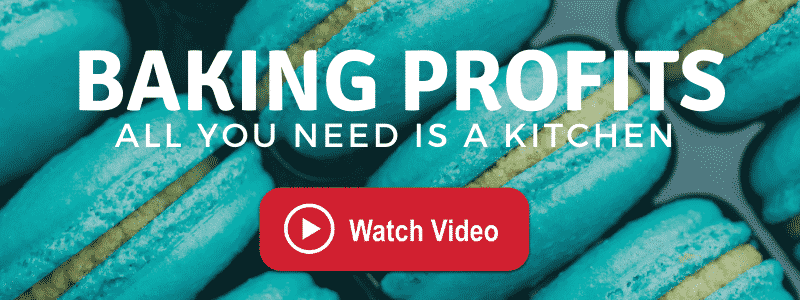
Potentially hazardous foods that require time and/or temperature control for safety are not allowed to be produced under this exemption. Examples of foods that are not allowed include:
- Meat and meat products including fresh and dried
meats (jerky) - Fish and fish products (e.g., smoke salmon, canned
salmon, etc.) - Raw seed sprouts
- Garlic in oil mixtures
- Baked products that require refrigeration (e.g.,
cheesecake, custards, lemon meringue) - Cheeses
- Dairy products (including ice cream)
- Non-acidic canned foods (i.e., canned vegetables that are not pickled or fermented)
- Pesto
- Fresh vegetable juices
- Food products made with cooked vegetables that are not acidified
- Bottled water
Real Life Cottage Food Entrepreneurs and Opportunities
- Cakes – teacher turns kitchen into bakery
- Doughnuts – cottage mini donut vendor
- Fruit jams and jellies – See Additional Requirements Here
- Kettle corn – real kettle corn vendors from home
- Popcorn (plain and flavored) – see a real home vendor here
ACIDITY LEVELS AND TESTING
Most states determine if a food is non-potentially hazardous by the acidity level found in the food. The higher the acidity, the more stable at a range of temps, that food product is.
For example: milk is low acidity and requires temperature controls.
The acidity of foods is measured by pH.
• The range of pH is commonly considered to extend from zero to 14. A pH value of 7 is neutral because pure water has a pH value of exactly 7. Values less than 7 are considered acidic, while those greater than 7 are considered basic or alkaline.
• All fruits are acidic foods and are usually tart and sour. Ex: tomato, lemon, peach, apple, etc.
• The FDA rule for acidic foods states that a food must have a pH below 4.6 to be sold as a minimally processed food.
• Reason for this is bacteria does not grow at this level of acidity.
• Exclusion shall not be construed as allowing the sale of low acid foods (pH > 4.6) in
hermetically sealed containers (i.e. home-canned green beans, peas, etc.) when such
food is not prepared in a permitted establishment. *Exceptions for Montgomery and Calhoun Counties.
TESTING
Some states require testing if the pH level is unknown. For many food products, the pH level is already known.
You can test for pH yourself using a pH spear tester. (make sure it is made for food and has a long spear tip).
Oklahoma State University shares an awesome guide for selecting the correct tester for foods and liquids which includes tips and tricks for operation and maintenance. Get The Guide Here.
SENDING OFF YOUR PRODUCTS FOR pH (acidity) TESTING
How Do I Get My Products Tested?
The Alaska State Environmental Health Laboratory can test your food products for pH and water activity for a small fee.
The cost for pH testing is $20 per sample, and the cost for water activity testing is $10 per sample.
Sending Samples to the Lab
- Download a Sample Submission Form from the laboratory website. Fill it out with your personal contact information, including an email address and information about the product.
- Carefully package and seal your product to prevent drying or leaking in shipping. The laboratory needs 8 ounces of product to test for both pH and water activity.
- Place a form of payment, the completed Sample Submission Form, and the sample in a package and ship to:
- Alaska State Environmental Health Laboratory
- 5251 Dr. Martin Luther King, Jr. Avenue
- Anchorage, AK 99507-1293
Call 907-375-8231, or email [email protected] to let them know you have shipped your package. You can expect results via email 5-10 business days after the package is received by the laboratory.
If you need quicker results, let the lab know and they will expedite as quickly as they can!
COTTAGE FOOD PRODUCT TESTING Q & A
Food sold under the Alaska Food Code exemption 18 AAC 31.012(a).
Why are foods required to be tested?
The regulation requires that documentation of demonstrating product safety be provided upon request.
You must demonstrate that either pH, water activity or both are sufficient to prevent dangerous bacteria from growing.
What kind of testing do I need to do?
For products like salsas, pickled vegetables and fermented foods, a pH test result of 4.6 or below is needed. For products like dehydrated foods, a water activity test result of 0.88 or below is required.
I want to sell baked goods. Do I need to get a water activity or pH test?
If your baked goods are non-potentially hazardous (i.e., no cream cheese frosting, custards, meringues, etc.), then the only documentation that you will need to provide is recipe formulation.
Where can I get my product tested?
Any number of food labs would be able to test your product. You can check around locally to see if anyone can provide that service.
Otherwise, the Alaska DEC Environmental Laboratory Services, Kodiak Seafood and Marine Science Center or Cooperative Extension Services can provide pH and water activity testing at a minimal cost.
You can also purchase your own water activity or pH meter to test your product.
How much does it cost to get my product tested?
Testing costs may vary depending on where you get your product tested.
Water activity and pH testing can be done through the Alaska DEC Environmental Laboratory Services or the Kodiak Seafood and Marine Science Center.
All locations charge the same: a pH test is $20 and water activity is $10 per sample.
Do I need to provide DEC with a copy of my test results?
No, you just need to keep a copy with you so you can demonstrate that the product is safe.
I want to sell my product at this week’s farmers market.
There isn’t time to get my product tested.
Does that mean I can’t sell?
You need to have proof, if asked, that the product you are selling is safe. Until you have that documentation your product is not considered safe.
ALASKA LIMITS INCOME FROM A COTTAGE FOOD BUSINESS
The maximum gross sales from your exempt products cannot exceed $25,000 in a calendar year.
Alaska Department of Environmental Conservation
Some cottage food owners have simply let another family member get licensed once they reach $25,000 in income so they can continue to do business, save and eventually open a commercial business.
HOW TO START YOUR COTTAGE FOOD BUSINESS IN ALASKA – START TODAY
NO LICENSE – NO TESTS – JUST GRAB A BUSINESS LICENSE AND START
- Keep and provide detailed knowledge about the ingredients of the food product and how it was processed, prepared, and packaged.
- Have the food product recipe or formulation available in case there is ever a concern about the safety of the product. For pickled or dried product the producer needs to have information available about the pH or water activity.
- Process, prepare, package, and sell the product only in Alaska
- Sell directly to the consumer by an individual who knows what ingredients were used to make the product and how the food was prepared and packaged. This individual must be able to answer consumers’ questions about the product, including whether allergens are present in the food product.
- Do not distribute or sell the product to stores, restaurants, by mail order, or on consignment.
- Keep total gross receipts of sales of food items to show gross sales do not exceed $25,000 within a calendar year.
- If the food is not prepared in a permitted, approved, or inspected kitchen, inform the consumer by a card, placard, sign, or label placed in a conspicuous area that states the following: “THESE PRODUCTS ARE NOT SUBJECT TO STATE INSPECTION.”
- Label packaged food with either: an Alaska Business License number OR the name, physical address, and telephone number of the individual who prepared the food. This allows DEC to trace the product back to the producer if there is a problem or complaint.
NOTE: ANCHORAGE has some different rules and requirements. Please contact the authorities in Anchorage for any specific requirements they require.
CONTACT HERE or See this guide here for information before contacting: Anchorage Alaska Cottage Food Rules
GET AN ALASKA BUSINESS LICENSE ONLINE
Simply click here to apply and receive your new Alaska business license. I suggest you check this page first for frequently asked questions / requirements.
ALASKA COTTAGE FOOD LAWS LABELING REQUIREMENTS
Most states require labeling on any product produced at a home kitchen. However, even if your state doesn’t require labeling, this is your chance to stand out and show you care.
The Alaska Cottage Food Laws requires the following on labels: Label packaged food with either: an Alaska Business License number OR the name, physical address, and telephone number of the individual who prepared the food.
This allows DEC to trace the product back to the producer if there is a problem or complaint. Note: All info or just your business license number
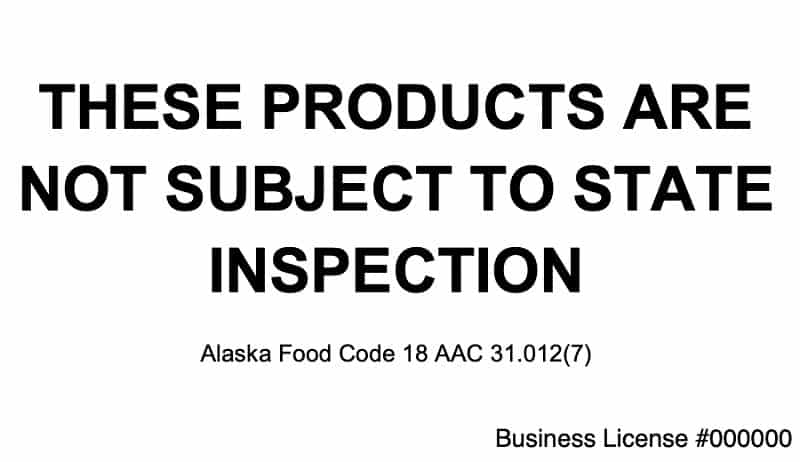
Below is an example of what the state of Arizona requires on their labels.
Using VistaPrint.com or similar – you can quickly create professional labels that not only serve to meet the state cottage food guidelines but also serve for marketing your awesome business and products.
You’ll find some fantastic examples of this from members inside VendorsUnited.com
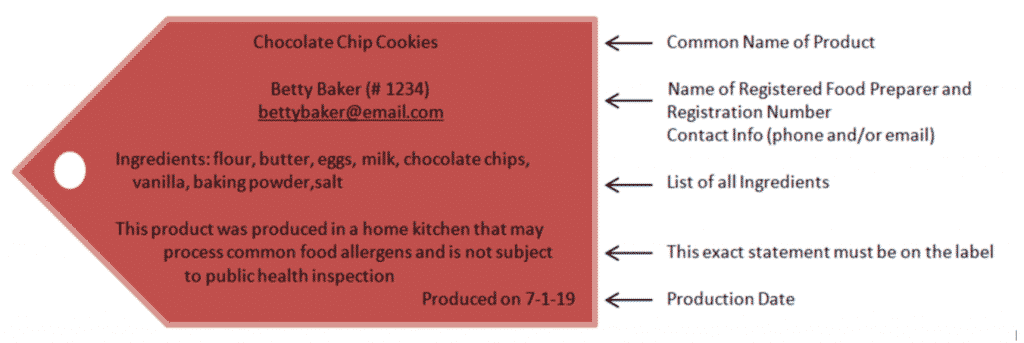
ALLERGENS ON LABELING
The FDA lists nine (9) major food allergens. Listing any of these on your label is a smart business practice and will certainly help your customers choose a product.
- Milk
- Eggs
- Fish (e.g., bass, flounder, cod)
- Crustacean shellfish (e.g., crab, lobster, shrimp)
- Tree nuts (e.g., almonds, walnuts, pecans)
- Peanuts
- Wheat
- Soybeans
- Sesame seeds
Simply add to your label: “NOTICE: SOYBEANS USED IN THIS RECIPE” Some go as far to announce that a certain allergen is used in the same kitchen.
Some states require you list any potential allergens and potential for any cross contamination even if the allergen is not used in the recipe.
WHERE CAN I SELL MY COTTAGE FOOD PRODUCTS
Food sold under the Alaska Food Code exemption 18 AAC 31.012(a).
- Where can I sell my finished product? – The intention of the cottage food regulation is for the producer (the person making the product) to sell his or her product directly to the ultimate consumer. This means that the person who is purchasing the food from you is using that food for personal use and does not intend to resell it (to the best of your knowledge).
- Products produced under the Cottage Food Exemption may be sold at farmers markets, fairs, bazaars and other venues where the product is sold directly to the consumer. Is there a limit to the amount I can sell? – The maximum gross sales from your exempt products cannot exceed $25,000 in a calendar year.
- Can I sell my product over the Internet? – No. You can advertise over the internet but the sales of your product must be direct in person to the consumer.
- Do I have to label my product? – There are specific labeling requirements associated with cottage foods. Foods sold under this exemption must have the statement “THESE PRODUCTS ARE NOT SUBJECT TO STATE INSPECTION.” The statement must be displayed on a card, placard or sign that is conspicuously displayed on each food product that is packaged. An example of a placard can be found on the DEC website.
- Can I sell my product in a retail food store (suchas a convenience store), espresso stand or temporary food booth? – No. All food that is in a permitted food establishment (like an espresso stand or retail food facility) must come from an approved source. Because products that are produced under this exemption are not produced in a licensed and inspected facility, they are not considered an approved source and may not be sold in permitted food establishments.
- I have a temporary food permit and will be selling at a local event. Can I use my cottage food in the products that I am selling in my temporary food booth? – No. All products that are sold in permitted food establishments (including temporary food booths) must use ingredients and products that come from an approved source. Because products that are produced under this exemption are not produced in a licensed and inspected facility, they are not considered an approved source. If you would like to sell items under the Cottage Food Exemptions at the same booth that has temporary food permit, the product must be clearly separated and properly labeled.
Inside kitchenincome.com you can find out how many cottage food entrepreneurs are getting sales faster than they can make the food.
cOTTAGE FOOD TIPS AND BEST PRACTICES
SAFE PRACTICES
Much of this may seem like common sense, but even if you already know, it’s a good idea to remind yourself with a list of things that can prevent you from missing something small.
And if for no other reason… CYA! CYA = Cover Your A#%
CLEAN WORK AREA / WORK SPACE / SANITIZATION
Providing safe to eat foods from your kitchen – starts in your kitchen.
Keep your area clean and sanitized to avoid cross contamination and to insure you provide your customers and clients with the safest and best foods they can get.
The following are some “common” sense things you can do to insure the best environment for preparing foods to sell:
- Keep all equipment and surface areas clean and sanitized
- Make sure window and door screens are bug proof with no gaps
- Keep ingredients separate to prevent cross contamination / e.g. raw eggs near flour
- No pets in work area and preferably none in the home
- Allow no-one with a cold, sniffles or sick in kitchen while preparing foods
- Wipe down walls and clean floors daily
- Use good lighting to avoid missing unclean areas
- Keep window and door screens in good repair to keep insects out
- Wash hands frequently while working and use food grade gloves for extra safety
- Keep areas of food storage and equipment storage clean and sanitized
RECORD KEEPING
Why keep these types of records?
Let’s say the inspector calls you and says they got a report that your banana bread, someone purchased, made them sick.
You’ll be able to show that you didn’t even make banana bread that week and that the person who reported you, bought that 4 weeks ago and you weren’t even the one that sold it to him.
This does not need to be complicated. I love my yellow legal pads and they make an inexpensive tool for keeping up with the following:
- The recipes you use including ingredients
- The process you use to prepare that specific recipe: (can be just like recipe instructions)
- Date made (can be coded for your own use only if your state doesn’t require the production date) e.g. Made 12.22.29 = 292212
- Date sold (you can have a batch code to help track a certain batch) Simply write down date you sold an item
- Location sold is another great piece of information to keep track of
- Sales receipts are something great to keep for a couple of reasons and over at KitchenIncome.com I dive into the best practices, best systems and best methods for tracking, managing, selling and shipping.
COTTAGE FOOD lIABILITY INSURANCE
We live in a society that likes to sue. I can sue you for wearing that color shirt. No kidding! Of course I probably won’t win, but at the very least, it’s gonna cause you stress and some costs.
Liability insurance is a MUST.
It can be expensive – but several years ago, I found FLIP and by far, they gave me the most protection (coverage) and allow you to run your cottage food business without fear of being sued.
WHY? Because they provide the lawyers. And their lawyers… they are good!
Of course you should price shop around with your local agent or a national brand company, but rest assured, I’ve done all the legwork for you.
Alternatively, some folks opt to get bonded. You’ve heard the saying before: “licensed and bonded”. A bond is usually provided from an insurance bonding company or your own insurance company.
My first time, I got a bond at State Farm.
A bond is expensive comparatively but is less out of pocket in the beginning. Of course, it’s way, way less insurance / coverage too.
A $10,000 bond may cost $50 annually while a $2,000,000.00 liability policy may cost a few hundred a year.
No matter what you decide… knowing you’re insured against frivolous lawsuits is worth every penny.
ALASKA COTTAGE FOOD RESOURCES
- Alaska Cottage Food Laws Facts
- Below image is a clickable link to the entire guide or click here
- Contact Anchorage authorities before starting within Anchorage, Alaska
- Anchorage, Alaska Cottage Food Laws (specific to Anchorage)
- Anchorage, Alaska Cottage Food Laws – Apply For a Variance
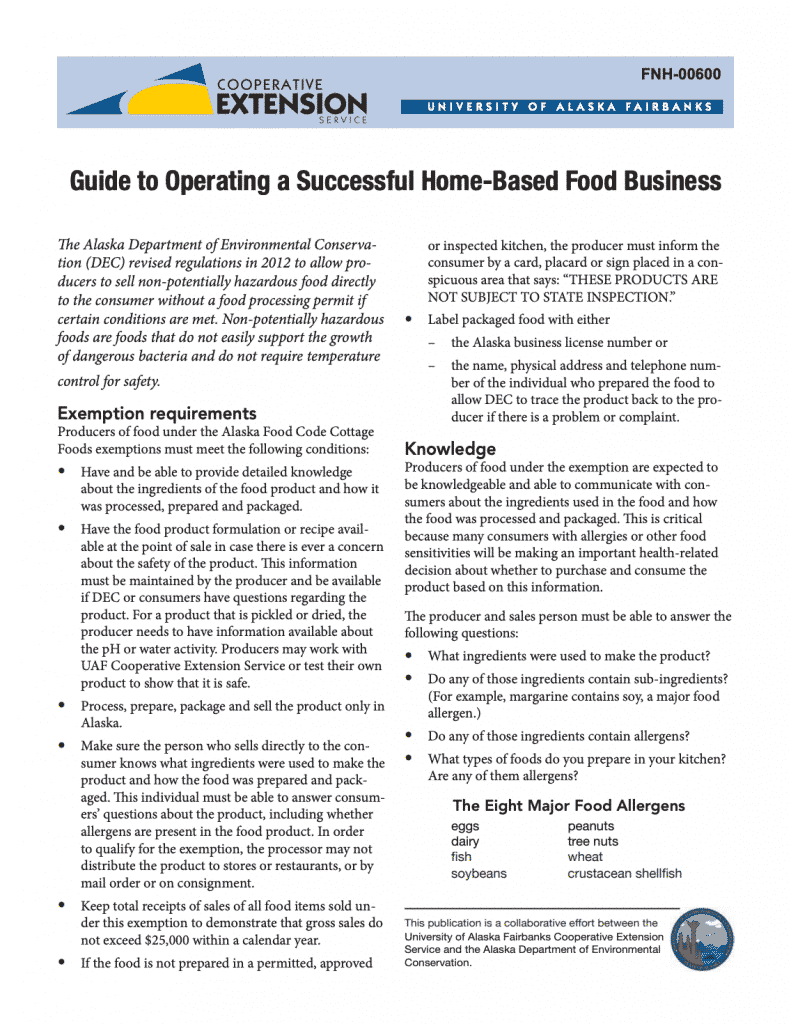
CONTACT ALASKA’S COTTAGE FOOD INDUSTRY FOR MORE HELP
- Cooperative Extension
308 Tanana Loop, Room 101
P.O. Box 756180
Fairbanks, Alaska 99775-6180
907-474-5211
[email protected]
- Program Manager:
Kimberly Stryker
1-87-SAFE-FOOD (1-877-233-3663)
907-269-7501
UPDATES TO ALASKA COTTAGE FOOD LAWS
From time to time, links, info, rules and numbers change, are updated or made obsolete.
Although I spend time daily with hundreds of vendors (many of which are cottage food businesses) – I can miss an update.
If you find a broken link or outdated state information… please let me know and I’ll send you a special thank you for helping me maintain the best site on the internet for the cottage food industry.
My goal has always been to have a central place that is absolutely free for those starting out or existing entrepreneurs who use their homes and kitchens to make real incomes.
Please send to [email protected] / or post inside the private VendorsUnited.com group.
Need more resources? Check it out HERE (Helpful Resources)
Take a peek at the best vendors on the planet, the community that rocks the food vending world: Vendors United…
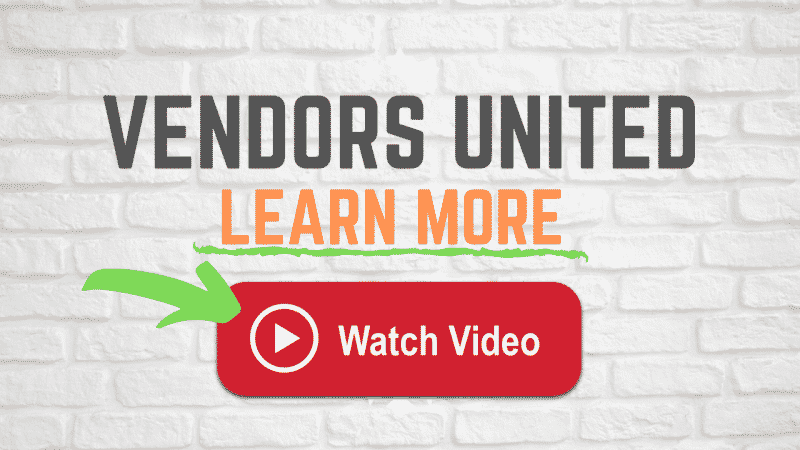
Disclaimer
This information is provided to help those interested in starting a cottage food business. It is not a document made by the state government. This information is not provided as law nor should be construed as law. Always use the contact information for each state to confirm compliance and any changes.
Did we help you? Help us to share this information…
 WATCH VIDEO!
WATCH VIDEO! WATCH VIDEO!
WATCH VIDEO!
I found nothing on Honey?
Hi, thank you for the question… we cover this inside the Vendors United group at vendorsunited.com, where you can talk with 100’s of real vendors and get instant advice that works
With all these laws, You may as well just go commercial and Pay the king his MOTHER MAY I TAX.